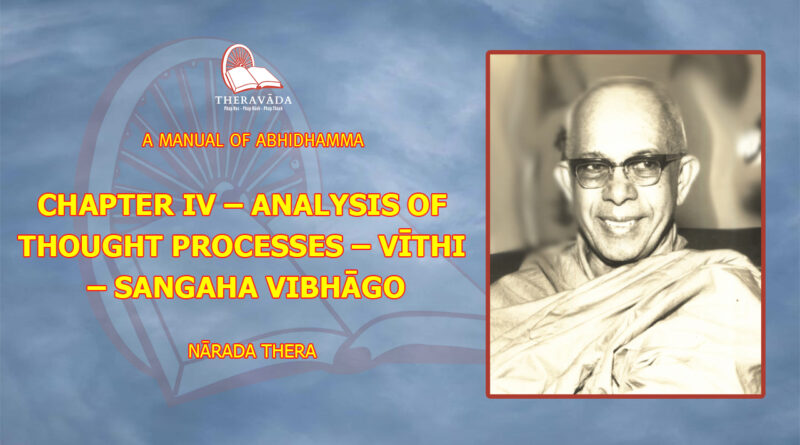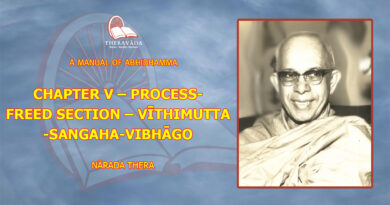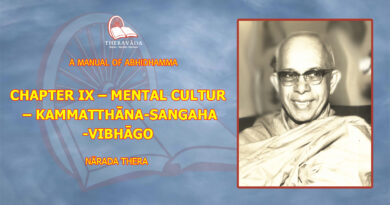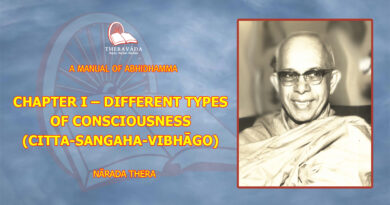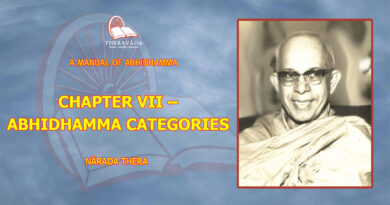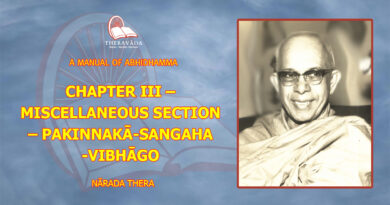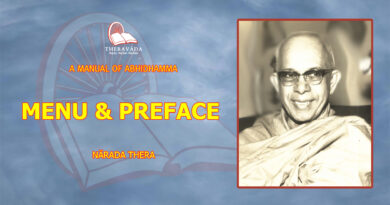Abhidhammattha-Sangaha
CHAPTER IV – Analysis of Thought-Processes
Vīthi – Sangaha Vibhāgo
§ 1. Cittuppādānamicc’ evam katvā sangaham uttaram
Bhūmi-puggalabhedena pubbāparaniyāmitam
Pavattisangaham nāma patisandhippavattiyam
Pavakkhāma samāsena yathāsambhavato
§ 2. Cha vatthūni, cha dvārāni, cha ālambanāni, cha viññānani, cha vīthiyo, chadhā visayappavatti c’āti vīthisangahe chachakkāni veditabbāni.
Vīthimuttānam pana kamma-kammani-mitta-gatinimitta-vasena tividhā hoti visayappavatti .
Tattha vatthudvārālambanāni pubbe vuttanayen’ eva.
Cakkhuviññānam, sotaviññānam, ghānaviññānam, jivhaviññānam, kāyaviññānam manoviññānam c’āti cha viññānāni.
Vīthiyo pana cakkhudvāravīthi, sotadvāra vīthi, ghānadvāravīthi, jivhādvāravīthi, kāyadvāravīthi, manodvāravīthi c’āti dvāravasena vā cakkhuviññānavīthi, sotaviññānavīthi, ghānaviññānavīthi, jivhāviññānavīthi, kāyaviññānavīthi manoviññānavīthi c’āti viññānavasena vā dvārappavattā cittappavattiyo yojetabbā.
§ 3. Atimahantam, mahantam, parittam atiparittam c’āti pañcadvāre manodvāre, vibhūtamavibhūtam c’āti chadhā visayappavatti veditabbā.
Katham?
Uppādatthitibhangavasena khanattayam ekacittakkhanam nāma. Tāni pana sattarasacittakkhanāni rūpadhammānam āyu. Ekacittakkhanātītāni vā, bahucittakkhanātītāni vā thitippattān’ eva pañcālambanāni pañcadvāre āpātham āgacchanti. Tasmā yadi ekacittakkhanātitakam rūpārammanam cakkhussa āpātham āgacchati. Tato dvikkhattum bhavange calite bhavangasotam vocchinditvā tam’eva rūpārammanam āvajjentam pañcadvārāvajjanacittam uppajjitvā nirujjhati . Tato tass’ ānantaram tam’ eva rūpam passantam cakkhuviññānam, sampaticchantam sampaticchanacittam, santīrayamanam santīranacittam, vavatthapentam votthapanacittam c’āti yathākkamam uppajjitvā nirujjhanti. Tato param ek’ ūnatimsakāmāvacarajavanesu yam kiñci laddhapaccayam yebhuyyena sattakkhattum javati. Javanānubandhāni ca dve tadārammanapākāni yathāraham pavattanti. Tato param bhavangapāto.
Ettāvatā cuddasacittuppādā dve bhavangacalanāni pubbevātītakamekacittakkhananti katvā sattarasa cittakkhanāni paripūrenti. Tato param nirujihati. ālambanam’ etam atimahantam nāma gocaram.
Yāva tadālamban’ uppādā pana appahon-tātītakam āpātham āgatam ālambanam mahantam nāma. Tattha javanāvasāne bhavangapāto’ va hoti. Natthi tadālambanuppādo.
Yāva javanuppādā’ pi appanontātītakamā-pātham āgatam ālambanam parittam nāma.
Tattha javanam pi anuppajjitvā dvattikkhatthum votthapanam’ eva pavattati. Tato param bhavangapāto’ va hoti.
Yāva votthapanuppāda ca pana appahontātītakam āpātham āgatam nirodhāsannamālambanam atiparittam nāma. Tattha bhavangacalanam’ eva hoti. Natthi vīthicittuppādo.
Icc’ evam cakkhudvāre, tathā sotadvārādīsu c’āti sabbathā’ pi pañcadvāre tadālambanajavana-votthapanamoghavāra-sankhātānam catunnam vārānam yathākkamam ālambanabhūta visayappavatti catudhā veditabbā.
§ 4. Vīthicittāni satt’ eva cittuppādā catuddasa Catupaññāsa vitthārā pañcadvāre yathāraham.
Ayam’ ettha pañcadvāre vīthicittappavattinayo.
Five Sense-Door Thought-process
Introductory
§ 1. Having thus completed the noble compendium of consciousness and its concomitants (with respect to feelings etc.), I shall briefly describe, in due order, the compendium of (thought) processes in lifetime, according to the planes and individuals, and as they are determined by what (consciousness) that precedes and by what that follows (1)
Notes:-
1. In the preceding chapter states of consciousness and mental concomitants were treated according to feelings, roots, etc. In the present one the author deals with thought processes as they arise through the mind and the other five senses, in accordance with the different kinds of individuals and planes of existence.
The Pāli phrase pubbāparaniyāmitam needs an explanation. The commentary explains it thus – this citta arises after so many cittas, and so many cittas follow this citta (idam ettakehi param, imassa anantaram, ettakāni cittāni).
Patisandhi here refers to the initial thought-process that occurs at the moment of conception in a new birth. Pavatti refers to all thought-processes that occur during the course of one’s lifetime.
The translation of these two verses appears in the Compendium of Philosophy as follows:-
“This further summary of geneses
Of thought now having made, I will go on
To speak concisely, summing up again
Processes of the mind, in birth and life,
By order due, the ‘after,’ the ‘before,’
Distinguishing both person and life-plane.’ (p. 124).
Thought-Processes
§ 2. In the compendium of thought-processes six kinds of six classes each should be understood – namely,
i. six bases, ii. six doors, iii. six objects*, iv. six-fold consciousness, v. six processes (2), and vi. sixfold presentation of objects (3)
The presentation of objects to the process-freed consciousness** is threefold – namely, (i) Kamma, (ii) Kamma sign, and (iii) Destiny sign.
[* These first three classes have already been discused in the previous chapter. They are repeated hero merely to complete the six groups.]
[** Namely, patisandhi, bhavanga and cuti.]
The bases, doors, and objects, therein, are as described before.
The sixfold types of consciousness are eye-consciousness, ear-consciousness, nose-consciousness, tongue-consciousness, body-consciousness, and mind-consciousness.
According to the doors the thought-processes are:-
1. The process connected with the eye-door,
2. The process connected with the ear-door,
3. The process connected with the nose-door,
4. The process connected with the tongue-door,
5. The process connected with the body-door, and
6. The process connected with the mind-door.
Or, according to consciousness the thought-processes are: –
1. The process connected with the eye-consciousness
2. The process connected with the ear-consciousness
3. The process connected with the nose consciousness,
4. The process connected with the tongue-consciousness,
5. The process connected with the body-consciousness, and
6. The process connected with the mind consciousness.
The thought-procedure connected with the doors should thus be co-ordinated.
§ 3. The sixfold presentation of objects (4) should be understood as follows:-
a. At the five sense doors –
(i) ‘very great,’ (ii) ‘great,’ (iii) ‘slight,’ (iv) ‘very slight.’
b. At the mind door –
(v) ‘clear’ and (vi) ‘obscure.’
How is the intensity of objects be determined?
The three instants such as genesis, static (or development), and dissolution constitute one thought-moment. The duration of material things consists of seventeen such thought-moments.
The five sense-objects enter the avenue of five sense doors at the static stage when one or several thought moments have passed.
Hence the thought-process (4) runs as follows: –
Suppose a visible object which has passed one instant (i) enters the avenue of eye. Then the bhavanga-consciousness vibrates for one moment and perishes, (ii, iii) arresting the bhavanga stream. Subsequently the five-door apprehending consciousness (iv) arises and ceases apprehending that very visible object.
Thereafter the following thought-moments arise and cease in order –
(v) eye-consciousness seeing that very form,
(vi) recipient consciousness receiving it,
(vii) investigating consciousness investigating it,
(viii) determining consciousness determining it.
Then any one of the 29 kinds of sense-sphere javanas, thus causally conditioned, runs mostly for seven moments (ix – xv).
Following the javanas two retentive resultants (xvi, xvii) arise accordingly. Finally comes the subsidence into the bhavanga.
Thus far seventeen thought-moments are complete, namely,
fourteen ‘thought-arisings’ (cittuppāda)
two vibrations of bhavanga, and
one thought-moment that passed at t he inception.
Then the object ceases.
Such an object is termed ‘very great.’ (See pp. 231, 232.)
That object which enters the avenue of sense, having passed (a few moments) and is not able to survive till the arising of the retentive thought-moments, is termed ‘great. ‘
That object which enters the avenue of sense, having passed (a few moments) and is not able to survive even till – the arising of the javanas, is termed ‘slight.’
In that case even the javanas do not arise, but only the determining consciousness lasts for two or three moments and then there is subsidence into bhavanga.
That object which is about to cease and which enters the avenue of sense, having passed a few moments and is not able to survive till the arising of determining consciousness, is termed ‘very slight.’
In that case there is merely a vibration of the bhavanga, but no genesis of a thought-process.
As the eye-door so is in the ear-door etc.
In all the five doors, the fourfold presentation of objects should be understood, in due order, in the four ways, known as –
1. the course (ending with) retention.
2. the course (ending with) javana.
3. the course (ending with) determining, and
4. the futile course.
§ 4. There are seven modes* and fourteen different types of consciousness in the thought-process. In detail there are accordingly 54** in the five doors.
Herein this is the method of thought-process in the five sense-doors.
[* Namely, 1. āvajjana, 2. pañca viññāna, 3. sampaticchana, 4. santīrana, 5. votthapana, 6. javana, (7 moments) and 7. tadālambana. These become 14 when the 7 javana moments and 2 tadālambanas are reckoned separately.]
[** These comprise all the classes of Sense-sphere consciousness which arise through the five sense-doors.]
Notes: –
2. Vīthi is derived from vi + Ö i, to go.
This term means a way or street, but here it is used in the sense of process (paramparā). A thought-process consists of several thought-moments, and a thought-moment is never called a citta-vīthi.
3. Visayappavatti –
The commentarial explanation is – ‘the presentation of objects at the doors,’ or ‘the genesis of consciousness on the presentation of such objects.’ (visayānam dvāresu, visayesu ca cittānam pavatti).
The author evidently prefers the first explanation.
4. Thought-processes
According to Abhidhamma ordinarily there is no moment when we do not experience a particular kind of consciousness, hanging on to some object – whether physical of mental. The time-limit of such a consciousness is termed one thought-moment. The rapidity of the succession of such thought-moments is hardly conceivable by the ken of human knowledge. Books state that within the brief duration of a flash of lightning, or in the twinkling of an eye billions of thought-moments may arise and perish.
Each thought-moment consists of three minor instants (khanas). They are uppāda (arising or genesis), thiti (static or development), and bhanga (cessation or dissolution).
Birth, decay, and death* correspond to these three states. The interval between birth and death is regarded as decay.
Immediately after the cessation stage of a thought-moment there results the genesis stage of the subsequent thought-moment. Thus each unit of consciousness perishes conditioning another, transmitting at the same time all its potentialities to its successor. There is, therefore, a continuous flow of consciousness like a stream without any interruption.
[*These three stages correspond to the Hindu view of Brahma (Creator). Vishnu (Preserver) and Siva (Destroyer).]
When a material object is presented to the mind through one of the five sense-doors, a thought-process occurs, consisting of a series of separate thought-moments leading one to the other in a particular, uniform order. This order is known as the citta-niyāma (psychic order). As a rule for a complete perception of a physical object through one of the sense-doors precisely 17 thought-moments must pass. As such the time duration of matter is fixed at 17 thought-moments. After the expiration of that time-limit, one fundamental unit of matter perishes giving birth to another unit. The first moment is regarded as the genesis (uppāda), the last as dissolution (bhanga), and the interval 15 moments as decay or development (thiti or jarā).
As a rule when an object enters the consciousness through any of the doors one moment of the life-continuum elapses. This is known as atīta-bhavanga. Then the corresponding thought-process runs uninterruptedly for 16 thought-moments. The object thus presented is regarded as ‘very great.’
If the thought-process ceases at the expiration of javanas without giving rise to two retentive moments (tadālambana), thus completing only 14 moments, then the object is called ‘great’.
Sometimes the thought-process ceases at the moment of determining (votthapana) without giving rise to the javanas, completing only 7 thought-moments Then the object is termed ‘slight.’
At times when an object enters the consciousness there is merely a vibration of the life-continuum. Then the object is termed ‘very slight.’
When a so-called ‘very great’ or ‘great’ object perceived through the five sense-doors, is subsequently conceived by the mind-door, or when a thought process arising through the mind-door extends up to the retentive stage, then the object is regarded as ‘clear’.
When a thought process, arising through the mind-door, ceases at the javana stage, the object is termed ‘obscure’.
When, for instance, a person looks at the radiant moon on a cloudless night, he gets a faint glimpse of the surrounding stars as well. He focuses his attention on the moon, but he cannot avoid the sight of stars around. The moon is regarded as a great object, while the stars are regarded as minor objects. Both moon and stars are perceived by the mind at different moments. According to Abhidhamma it is not correct to say that the stars are perceived by the sub-consciousness and the moon by the consciousness.
Manodvāre Vīthi-Cittappavattinayo
§ 5. Manodvāre pana yadi vibhūtamālambanam āpātham āgacchati, tato param bhavangacalana – manodvārāvajjanajavanāvasāne tadārammanapākāni pavattanti. Tato param bhavangapāto.
Avibhūte panālambane javanāvasāne bhavangapāto’ va hoti. Natthi tadālambanuppādo’ti.
§ 6. Vīthicittāni tīn’eva cittuppādā daseritā
Vitthārena pan’ etthekacattālīsa vibhāvaye.
Ayam’ ettha Paritta-javanavāro.
Mind-door Thought-Process
§ 5. In the mind-door, when a ‘clear object’ enters that avenue, retentive resultants take place at the end of the bhavanga vibrations, mind-door apprehending consciousness, and Javanas. After that there is subsidence into the bhavanga.
In the case of all ‘obscure object’ there is subsidence into bhavanga at the end of the Javanas, without giving rise to the retentive resultants.
§ 6. Three modes and ten* different types (of consciousness) in the thought-process are told. It will be explained that, in detail, there are 41** kinds here.
Herein this is the section of the minor javana-procedure.
[* Namely, (1) manodvārāvajjana, javana, and tadālambana. When the 7 javanas and 2 tadālambanas are reckoned separately they total 10 distinctive thought-moments.]
[**Afore-said 54-13 (dvipañcaviññāna 10 + sampaticchanas, 2 and pañcadvārāvajjana 1) = 41.]
Appanā-vīthicittappavattinayo
§ 7. Appanājavanavāre pana vibhūtāvibhūtabhedo natthi. Tathā tadālambanuppādo ca.
Tattha hi ñānasampayuttakāmāvacarajavanānam atthannam aññatarasmim parikammupacārāñulomagotrabhū nāmena catukkhattum tikhattum’ eva vā yathākkamam uppajjitvā niruddhe tadanantaram’ eva yathāraham catuttham pañcamam vā chabbīsati mahaggatalokuttarajavanesu yathābhinīhāravasena yam kiñci javanam appanāvīthimotarati. Tato param appanāvasāne bhavangapāto’va hoti.
Tattha somanassasahagatajavanān’antaram appanā’ pi somanassasahagatā’ va pātikankhitabbā. Upekkhāsahagatajavananāntaram upekkhāsahagatā’ va. Tatthā’ pi kusalajavanā-nantaram kusalajavanan c’eva hetthimañca phalattayamappeti. Kriyājavanānantaram kriyā javanam arahattaphalañ ca appeti.
§ 8. Dvattimsa sukhapuññamhā dvādasopekkhakā param
Sukhitakriyato attha cha sambhonti upekkhakā.
Puthujjanāna sekkhānam kāmapuññā tihe tuto
Tihetukāmakriyato vitarāganam appanā.
Ayam’ ettha manodvāre vīthi-cittappavatti nayo.
Appanā Thought-Process
§ 7. In the ecstatic (5) javana-procedure there is no distinction between ‘clear’ and ‘obscure.’ Likewise there is no arising of retentive resultants.
In this case any one of the eight Sense-sphere javanas accompanied by knowledge, arise, in due order, four times or thrice, as ‘preparation’ (parikamma), ‘approximation’ (upacāra), ‘adaptation’ (anuloma), and ‘sublimation’ (gotrabhū). Immediately after they cease, in the fourth or fifth instant as the case may be any one of the javanas amongst the 26 Sublime and Supramundane classes, descends into ecstatic process, in accordance with the appropriate effort.
Here, immediately after a pleasurable javana, a pleasurable ecstatic javana should be expected. After a javana, accompanied by equanimity, an ecstatic javana, accompanied by equanimity, is to be expected.
Here, too, a moral javana, is followed by a moral javana and (in the case of attainment – samāpatti) it gives rise to three lower Fruits.
A functional javana is followed by a functional javana and the Fruit of Arahatship.
§ 8. After (tihetuka) (6) pleasurable meritorious thoughts (7) arise 32 (classes of consciousness) (8); after (tihetuka) meritorious thoughts, accompanied by equanimity, 12 classes of consciousness (9); after (tihetuka)pleasurable functional thoughts, 8 classes of consciousness (10); and after (tihetuka) functional thoughts, accompanied by equanimity, 6 classes of consciousness (11).
To the worldlings and Sekhas ecstasy results after tihetuka Sense-sphere meritorious thoughts, but to the Lustless (Arahats) after tihetuka Sense-sphere functional thoughts.
Herein this is the method of thought-processes with respect to mind-door.
Notes: –
5. Appanā – (Sanskrit – arpanā, derived from Ö ri, to go).
This is a rare Pāli term found in Abhidhamma.
It is derived from the root Ö i, to go
‘Ö I + the causal suffix; ‘āpe’ + ana.‘A’ is substituted for ‘i’, and ‘p’ is duplicated; ‘A’ + ppe + ana = appanā. The initial ‘ā’ is shortened before double ‘p’.
Venerable Buddhaghosa defines ‘appanā’ as the directing or fixing of the one-pointed consciousness on an object (ekaggam cittam ārammane appenti).
Appanā is a highly developed form of vitakka – initial application of the mind, one of the jhāna factors.
The aspirant who wishes to develop jhānas takes for his object a suitable subject, according to his temperament. In the course of his meditations, as mentioned in the first chapter, he arrives at a stage when he would be able to experience the first jhānic ecstasy.
Then a thought-process runs as follows –
manodvārāvajjana – parikamma – upacāra – anuloma – gotrabhū – appanā
The first is the mind-door consciousness, which precedes the javana stage, conditioned by objects that enter the avenue of consciousness.
The initial thought-moment of the appanā javana-process is termed parikamma because it is a preparation for the desired higher consciousness whether Sublime (mahaggata) or Supramundane (lokuttara). This is followed by another thought-moment known as upacāra because it arises in proximity to the higher consciousness. Ordinarily these two thought-moments arise at the beginning of the appanā javana-process, but if the person is morally advanced only upacāra moment arises without the initial parikamma moment.
The third thought-moment is known as anuloma because it arises in harmony with the preceding thought moments and the following gotrabhū thought moment. Gotrabhū, literally, means that which overcomes the Sense-sphere lineage or that which develops the sublime or exalted lineage. Immediately after this gotrabhū thought-moment arises the appanājhāna thought-moment. Absolute one-pointedness of the mind is gained at this advanced stage of mental development.
The fully undeveloped jhāna, present in the preliminary thought-moments, is known as upacāra samādhi, access concentration.
To a worldling and a Sekha one of the four kāmāvacara moral javanas, accompanied by knowledge, arises as these preliminary appanā thought-moments. In the case of an Asekha it is one of the four kāmāvacarafunctional javanas, accompanied by knowledge.
The Supramundane appanā javana-process occurs as follows –
| 1 | 2 | 3 | 4 | 5 | 6 | 7 |
| parikamma | upacāra | anuloma | gotrabhū | magga | phala | phala |
In this thought-process parikamma may or may not precede. As stated above it depends on the moral advancement of the person. Here gotrabhū means that which overcomes the lineage of the worldling or that which develops the supramundane lineage.
One of the four kāmāvacara moral javanas, accompanied by knowledge, arises in these preliminary stages. The object of the first three thought-moments is mundane but the object of the gotrabhū is supramundane Nibbāna. Nevertheless, this developed thought-moment is incapable of eradicating the innate defilements. It is the magga (Path) consciousness that immediately follows, which performs the double function of intuiting Nibbāna and of eradicating the defilements. It should be noted that the Path consciousness occurs only once. This is immediately followed by two moments of phala (Fruit) consciousness if parikamma is present. Otherwise there will be three phala thought-moments.
In the case of the second, third, fourth, stages of Sainthood-the fourth thought-moment is named vodāna, which means purification, instead of gotrabhū. If the parikamma thought-moment precedes, vodāna thought-moment arises as the fourth, otherwise as the third.
Each of the four Supramundane Paths arises only once in the course of one’s life. But one may experience the Fruit consciousness even for a whole day continuously. The three lower fruits, Sotāpatti, Sakadāgāmi, and Anāgāmi are preceded by a moral javana. When one enjoys the Fruit of Arahatship the javanas that immediately precede must be functionals because an Arahat, being an Asekha does not experience moral javanas.
6. Tihetuka – conditioned by three hetus – alobha (generosity), adosa (goodwill) and amoha (wisdom)
7. Viz., two types of kāmāvacara consciousness, accompanied by pleasure and knowledge.
8. Namely, the first 4 rūpa jhānas and 28 (7×4) lokuttara jhānas. The Arahat Fruit and functionals are excluded.
9. Namely, 1, 5th rūpa jhāna + 4 arūpa jhānas + 7 lokuttara pañcamajjhāna.
10. Namely, 1st 4 rūpa jhānas + 1st 4 arahatta phala jhānas.
11. Namely, 1, 5th rūpa jhāna + 4 arūpa jhānas + 1, 5th arahattaphalajhāna.
Tadārammana Niyamo
§ 9. Sabbattha’ pi pan ettha anitthe ārammane akusalavipākān’ eva pañcaviññānasampaticchanasantīranatadārammanāni, itthe kusalavipākani, ati-itthe pana somanassasahagatān’ eva santīranatadārammanāni.
Tattha’ pi somanassasahagatakriyājavanāvasāne somanassasahagatān’ eva tadārammanāni bhavanti. Upekkhāsahagatakriyā javanāvasāne ca upekkhāsahagatān’ eva honti.
Domanassasahagatajavanāvasāne ca pana tadārammanāni c’ eva bhavangāni ca upekkhā sahagatān’eva bhavanti. Tasmā yadi somanassa-patisandhikassa domanassasahagatajavanāvasane tadārammanasambhavo natthi. Tadā yam kiñci paricitapubbam parittārammanamārabbha upekkhāsahagatasantīranam uppajjati. Tamanantaritvā bhavangapāto’ va hotī’ ti’ pi vadanti ācariyā. Tathā kāmavacarajavanāvasāne kāmāyacarasattānam kāmāvacaradhammesv’ eva ārammanabhūtesu tadārammanam icchantī’ ti.
§ 10. Kāme javanasattārammanānam niyame sati
Vibhūte ti mahante ca tadārammanamīritam.
Ayam’ ettha Tadārammana Niyamo.
The Procedure of Retention
§ 9. Here, under all circumstances (i.e., in both sense-door and mind-door) when an object (12) is undesirable, the five sense-impressions, reception, investigation, retention (that arise) are immoral resultants. If desirable, they are moral resultants. If the object is extremely desirable, investigation and retention are accompanied by pleasure.
In this connection, at the end of functional javanas accompanied by pleasure, there arise retentive thought-moments also accompanied by pleasure. At the end of functional javanas, accompanied by equanimity, the retentive thought moments are also accompanied by equanimity.
But at the end of javanas, accompanied by displeasure, the retentive thought- moments and the bhavangas are also accompanied by indifference. Hence to one whose rebirth-consciousness is accompanied by pleasure, if, at the end of javanas, accompanied by displeasure, retentive thought-moments do not arise, then, there arises an investigating consciousness accompanied by indifference, hanging on to some sense-object with which one is familiar before. Immediately after, the teachers say there is subsidence into the life-continuum.
Likewise they expect retention at the end of Sense-sphere javanas to the Sense-sphere beings, only when Sense-sphere phenomena become objects.
§ 10. Retention occurs, they say, in connection with ‘clear’ and ‘very great’ objects when there is certainty as regards the Sense-sphere javanas, beings, and objects.
Herein this is the procedure of retention.
Notes:-
12. Objects – ārammana
The desirability or undesirability of an object is determined not according to individual temperament, but according to its intrinsic nature. The resultant consciousness conditioned thereby is regarded as the effect of one’s good or bad action.
The sight of the Buddha will perhaps be repulsive to a staunch heretic. His javana thoughts will naturally be unwholesome. But the passive wholesome resultant eye-consciousness, caused by a past good kamma, is a kusala vipāka. This vipāka is not conditioned by his will, but is an inevitable consequence. The javana process, on the contrary, is conditioned by his own will.
Again, for instance, the mere sight of excreta will be a source of delight to an ordinary dog. The object is generally undesirable and is a bad effect (akusala vipāka), but the javana process caused thereby will be wholesome to the dog. The accompanying feeling will also be pleasurable.
Although even an Arahat experiences an akusala vipāka at the sight of an undesirable object, his javana process will neither be wholesome nor unwholesome. The accompanying feeling will be one of equanimity.
Now, when an undesirable object is presented either through the mind-door or five sense-doors, the sense-impressions, reception, investigation, retention that occur in the respective thought-processes, are all bad effects (akusala vipākas). The accompanying feeling is invariably upekkhā, except in the case of body-impression which is dukkha. These thought-moments are the inevitable results of past bad actions.
If the presented object is desirable, then the afore-said thought-moments are all good effects (kusala vipākas). Here too the accompanying feeling is upekkhā, except in the case of body-impression which is sukha. All these thought-moments are the results of past good actions.
When the object is extremely desirable, the feeling of the santīrana moment differs. Instead of upekkhā it is somanassa.
The tadārammanas followed by Sense sphere functional javanas, accompanied by pleasure, are also associated with a similar feeling. Likewise the upekkhā javanas are followed by upekkhā tadārammanas.
As a rule the preceding javanas and the subsequent tadārammanas possess a similar feeling. Somanassa is followed by somanassa, and upekkhā by upekkhā.
What happens when the javanas are accompanied by domanassa as there are no domanassa tadārammanas?
If the rebirth-consciousness (patisandhi-citta) of the person is accompanied by somanassa, then when javanas are accompanied by domanassa, the tadārammanas, if they occur, will be accompanied by equanimity (upekkhā-sahagata), but if tadārammanas do not occur, then an adventitious upekkhāsantīrana, without any special function, will intervene for one moment. This adventitious thought-moment is technically termed āgantukabhavanga. Usually the object of the javanas and that of the tadārammanas are identical. But in this particular case the objects differ. The object of this santīrana is another kāmāvacara object with which one is familiar in the course of one’s life. This object is termed paritta (smaller or lesser) in comparison with the higher rūpa, arūpa and lokuttara objects.
If, on the other hand, the rebirth-consciousness is not associated with somanassa, then the tadārammanas therein become upekhā as are the bhavangas that follow.
It should be noted that tadārammanas occur only at the end of kāmāvacarajavanas, only to kāmāvacara beings, and only in connection with kāmāvacara objects, which are either ‘very intense’ or ‘clear.’
Javana – Niyamo
§ 11. Javanesu ca parittajavanavīthiyam kāmāvacarajavanāni sattakkhattum chakkhattum’ eva vā javanti.
Mandappavattiyam pana maranakālādīsu pañcavāram’eva.
Bhagavato pana yamakapātihāriyakālādīsu lahukappavattiyam cattāri pañca vā paccavekkhanacittāni bhavantī’ ti pi vadanti.
ādikammikassa pana pathamakappanāyam mahaggatajavanāni, abhiññājavanāni ca sabbadā pi ekavāram eva javanti Tato param bhavangapāto.
Cattāro pana magguppādā ekacittakkhanikā. Tato param dve tīni phalacittāni yathāraham uppajjanti. Tato param bhavangapāto.
Nirodhasamāpattikāle dvikkhattum catutthāruppajavanam javati. Tato param nirodham phusati. Vutthānakāle ca anāgami phalam vā arahattaphalam vā yathāraham ekavāram uppajjitvā niruddhe bhavangapāto’ va hoti.
Sabbatthā’ pi samāpattivīthiyam pana bhavvangasoto viya vithiniyamo natthī’ ti katvā bahūni pi labbhantī’ ti, veditabbam.
§ 12. Sattakkhattum parittāni maggābhiññā sakim
Avasesāni labhanti javanāni bahūni’pi.
Ayam’ ettha Javana-Niyamo.
Procedure of Javana (13)
§ 11. Amongst the javanas, in a minor process, the sense-sphere javanas run only for seven or six times.
But in the case of a feeble process and at the time of dying, etc., only five times.
To the Exalted One, at the time of the ‘Twin Psychic Phenomenon’ and the like, when the procedure is alert, only four or five reflective thought-moments arise, they say.
To the beginner, during the first ecstasy, the Sublime javanas and super-intellect javanas run only once at all times. Subsequently there is subsidence into the life-continuum.
The arising of the four Paths endures for only one thought-moment. Thereafter two or three Fruit thought-moments arise accordingly. Then comes subsidence into life-continuum .
At the time of Supreme Cessation (14) the fourth arūpa javana runs twice and then contacts Cessation. When emerging (from this ecstasy) either Anāgāmi Fruit-consciousness or Arahatta Fruit-consciousness arises accordingly. When it ceases there is subsidence into the life-continuum .
In the process of Attainments there is no regularity of thought-processes, as in the stream of the life-continuum. Nevertheless, it should be understood that many (Sublime and Supramundane) javanas take place.
§ 12. It should be known that minor javanas arise seven times, the Path and Super-intellect only once, the rest (Sublime and Supramundane) several times.
Herein this is the procedure of javanas.
Notes:
13. Javana –
As it is difficult to give an adequate English rendering for javana, the Pāli term has been retained here.
Both psychologically and ethically javana thought-moments are the most important, as both good and evil are determined at this stage.
Sometimes the javanas last only for one moment. At times they may continue for seven moments at the most.
Kāmāvacara javanas, as a rule, last only for six or seven moments. When one is in a senseless state or is about to die, javanas are confined to five moments.
When the Buddha, by His psychic powers, emits fire and water, almost simultaneously, from His body, only four or five javana thought-moments arise so as to reflect on the jhāna factors, which is a prerequisite, for the performance of this ‘Twin Psychic Phenomenon’.
In the case of a yogi who develops the first jhāna for the first time, javana lasts only for one moment. So is it with those who develop the five abhiññās – namely, i. Psychic Powers (Iddhividha), ii. Celestial Ear (Dibba Sota), iii. Celestial Eye (Dibba Cakkhu), iv. Reading of Others’ Thoughts (Paracittavijānana), and v. Reminiscence of Previous Births (Pubbe-nivāsānussati ñāna). The four classes of supramundane javana Path-consciousness also last for one moment only. It is at this great moment that Nibbāna is intuited.
14. Nirodha Samāpatti –
An Anāgāmi or an Arahat, who has developed the rūpa and arūpa jhānas, could, by will-power, temporarily arrest the ordinary flow of consciousness even for seven days continuously. When one attains this state, all mental activities cease, although there exist heat and life devoid of any breathing. The difference between a corpse and one in this state, is that the latter possesses life. Books state too that his body cannot be harmed. The attainment of such an ecstatic state is known as nirodhasamāpatti. Nirodha means cessation, and samāpatti is attainment.
Immediately prior to the attainment of this state he experiences for two moments the fourth arūpa jhāna (state of neither perception nor non-perception). The flow of consciousness then ceases until he emerges therefrom as determined by him. As a rule he remains in this state for about a week. Motionless he abides in this ecstasy. Books relate an incident of a Pacceka Buddha whose body was set fire to while in this state. But he was not affected thereby.
Now when he emerges from this state the first thought-moment to arise is an Anāgāmi Fruit-consciousness in the case of an Anāgāmi, or an Arahat Fruit-consciousness in the case of an Arahat. Thereafter the stream of consciousness subsides into bhavanga.
Puggala-Bhedo
§ 13. Duhetukānam ahetukānañca pan’ettha kriyā-javanāni c’eva appanājavanāni ca na labbhanti. Tathā ñānasampayuttavipākāni ca sugatiyam, duggatiyam pana ñānavippayuttāni ca mahā-vipākāni na labbhanti.
Tihetukesa ca khīnāsavānam kusalākusala-javanāni ca na labbhantī’ti. Tathā sekkhaputhu-jjanānam kriyājavanāni. Ditthigatasampayuttavicik cchājavanāni ca sekkhānam. Anāgāmi-puggalānam pana patighajavanāni ca na labbhanti. Lokuttarajavanāni ca yathāsakamariyānam eva samuppajjantī’ ti.
§ 14. Asekkhānam catucattālīsasekkhānam uddise Chapaññāsāvasesānam catupaññāsa sambhavā.
Ayam ettha puggalabhedo.
Classification of Individuals
§ 13. Herein, to those whose rebirth-consciousness is conditioned by two roots (alobha and adosa) and conditioned by none, functional javanas and ecstatic javanas (*1) do not arise. Likewise, in a happy plane, resultants, accompanied by knowledge, also do not arise (*2). But in a woeful state they do not also get great resultants dissociated with knowledge
To the Corruption-freed (Arahats) amongst those whose rebirth-consciousness is conditioned by three roots, no moral nor immoral javanas arise. Similarly to the Sekhas and worldlings functional javanas do not arise. Nor do the javanas connected with misbelief and doubts arise to the Sekhas.(*3) To the Anāgāmi individuals there are no javanas connected with aversion. (*4) But the supramundane javanas are experienced only by Ariyas (*5) according to their respective capacities.
§ 14. As they arise it is stated that Asekhas experience 44 (*6), Sekhas 56 (*7), and the rest 54 (*8) classes of consciousness.
Herein this is the classification of individuals.
(*1) It is only a tihetuka individual that could develop Jhānas or attain Sainthood.
(*2) Owing to the inferiority of the rebirth-consciousne tihetuha tadālambanas do not arise.
(*3) Because they are eradicated on attaining sotāpatti.
(*4) Because an Anāgāmi eradicates sense-desires and aversion.
(*5) All the four classes of Saints are called Ariyas because they are far removed from passions.
(*6) Namely, 18 ahetukas + 16 sobhana kriyā and vipāka, + 9 rūpa and arūpa kriyā, + 1 arahatta Phala.
(*7) Namely, 7 akusalas + 21 (8+ 5 + 4 + 4) kusalas + 23 kāmāvacara vipākas + 2 āvajjanas + 3 phalas.
(*8) To worldlings 54, namely, 12 akusalas + 17 ahetukas + 16 sobhana kusala and vipākas + 9 rūpa and arūpakusalas.
Bhūmi-Bhedo
§ 15. Kāmāvacarabhūmiyam pan’ etāni sabbāni ‘pi vīthicittāni yathāraham upalabbhanti. Rūpavacarabhūmiyam patighajavanatadālambana-vajjitāni.
Arūpavacarabhūmiyam pathamamaggarūpāvacarahasanahetthimāruppavajjitāni ca labbhanti.
Sabbatthā’pi ca tam pasādarahitānam tam tam dvārikavīthicittāni na labbhant’ eva.
Asaññasattānam pana sabbathā’pi cittappavatti natth’evā’ti.
§ 16. Asītivīthicittāni kāme rūpe yathāraham
Catusatthi tathāruppe dvecattālīsa labbhare.
Ayam’ettha Bhūmivibhāgo.
§ 17. Icc’evam chadvārikacittappavatti yathāsambhavam bhavangantaritā yāvatāyukamabbhocchinnā pavattatī’ ti.
Iti Abhidhammattha-Sangahe Vīthi-Sangaha-Vibhāgo nāma Catuttho-Paricchedo.
Section on Planes
§ 15. In the Sense sphere all these foregoing thought-processes occur according to circumstances.
On the Plane of Form (all) with the exception of javanas connected with aversion and retentive moments.
On the Formless Plane (all) with the exception of the First Path, rūpāvacara consciousness, smiling consciousness, and the lower arūpa classes of consciousness.
In all planes, to those who are devoid of sense-organs, thought-processes connected with corresponding doors do not arise.
To those individuals without consciousness there is absolutely no mental process whatsoever.
§ 16. In the sense-sphere, according to circumstances, 80 (*1) thought-processes are obtained, on the Plane of Form 64 (*2), on the Formless Plane 42 (*3).
Herein this is the section on Planes.
§ 17. Thus the thought-processes connected with six doors, as they arise, continue without any break, intercepted by bavangas, while life lasts.
Thus ends the fourty chapter in the Compendium of Abhidhamma, entitled the Analysis of Thought-processes.
(*1) Namely, 54 kāmāvācaras + 18 rūpa and arūpa kusalas and kriyās + 8 lokuttaras = 80.
(*2) Namely, 10 akusalas (excluding 2 patighas) + 9 ahetuka vipākas (excluding kāya, ghāna and jivhā viññānas) + 3 ahetuka kriyās + 16 kāmāvacara kusalas and kriyās + 10 rūpa kusalas aud kriyās + 8 arūpa kusalas and kriyās + 8 lokuttaras = 64.
(*3) Namely, 10 akusalas + 1 manodvārāvajjana + 16 kāmāvacara kusalas and kriyās + 8 arūpa kusalas and kriyās + 7 lokuttaras (excluding sotāpatti magga) = 42.
Diagram IX
Thought-Processes
When, for instance, a visible object enters the mind through the eye-door, a thought-process runs as follows –
Pañcadvāra citta vīthi – Ati Mahanta
1 atīta bhavanga
2 bhavanga calana
3 bhavañgupaccheda
4 pañcadvārāvajjana
5 cakkhu viññāna
6 sampaticchana
7 santīrana
8 votthapana
9 – 15 javana
16 – 17 tadārammana
Immediately after this five sense-door thought-process, the stream of consciousness subsides into bhavanga. Then there arises a mind-door thought-process perceiving the aforesaid visible object mentally as follows –
Manodvārika Vīthi
| 1 | manodvārāvajjana |
| 2 – 8 | javana |
| 9 – 10 | tadārammana |
Again the stream of consciousness subsides into bhavanga, and two more similar thought-processes arise before the object is actually known.

